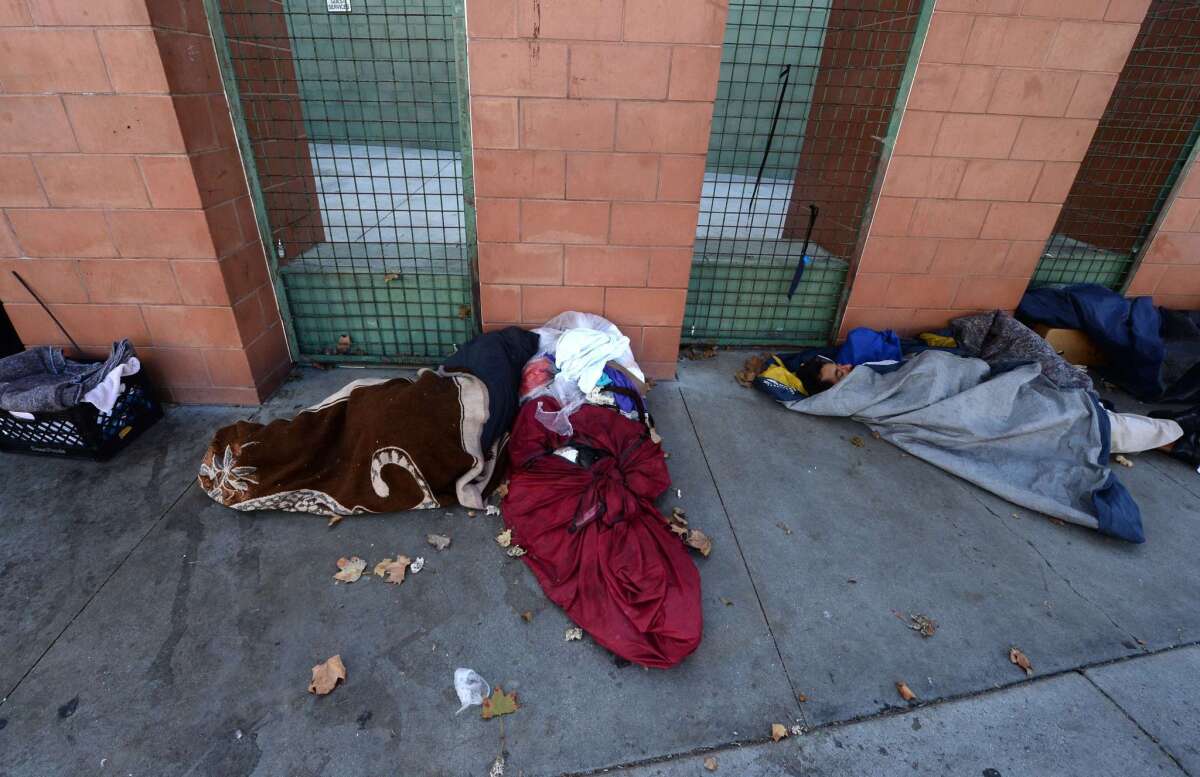Skid row groups are divided over future of homeless district

- Share via
A deep divide over the future of skid row and of the thousands of homeless people living in the 50-block district’s streets and shelters emerged during a community forum in downtown Los Angeles on Monday night.
The near-capacity crowd in the Los Angeles Theatre Center’s 470-seat auditorium split nearly evenly on key issues in instant electronic polls conducted during the meeting, including a proposal by City Councilman Jose Huizar, who convened the meeting, to appoint a homeless czar. The audience was also divided on whether skid row needs more homeless housing, more mixed-income housing or no more housing at all.
Midway through the two-hour forum, members of Los Angeles Community Action Network staged an angry walkout, protesting what they said was the exclusion of skid row residents from the panel of 15 people, mainly city and county officials, that Huizar assembled to testify about the 50-block downtown neighborhood.
“You messed up enough people already,” said General Dogon, an organizer for the poverty group, flinging onto the stage the electronic clicker that audience members used to vote.
“We are the experts” and “Vote of no confidence” read signs the group’s members raised in silent protest before the walkout.
Mental health, sanitation, police, health services and housing officials told the crowd they were working to maximum capacity on the community’s homeless problems.
Los Angeles Police Lt. Lionel Garcia said the department’s mental health response teams handle 13,000 crisis calls a year and don’t have the resources for outreach on skid row. City street services enforcement chief Gary Harris said dumping by local businesses exacerbates the trash can shortage and sanitation problems on skid row.
Most speakers agreed that skid row is not working. With the downtown’s glitzy revival encroaching on its boundaries, the neighborhood is changing, downtown developer Tom Gilmore said.
“There will be development of skid row,” said Gilmore, who predicted that mixed-income and market rate housing will grow without displacing shelters and other homeless services.
Housing chief Rushmore D. Cervantes said the city expects to finish building 1,250 homeless units next year, but added, “You walk down the streets and it doesn’t appear to have made things better. It appears things are even worse.”
Marc Trotz, who heads the Los Angeles County Health Services’ Housing for Health program, added a bright note, saying that his office hopes to create 10,000 housing units with services for homeless people with complex medical and behavioral issues.
“We have to open up to a really large mobilization,” Trotz said. “When you have earthquakes or floods you don’t wander around with a ragtag bunch of folks and two backpacks.”
Several longtime leaders boycotted the meeting, including Alice Callaghan, who runs Las Familias Del Pueblo, a skid row school and day-care center for children of immigrant workers. Callaghan lambasted the “Plan for Hope” Huizar used as a blueprint for the discussion, in part because its authors were described as “anonymous stakeholders.”
Callaghan said the report was riddled with illegal or outlandish ideas and factual errors, including a call to protect 6,000 existing low-income units on skid row. “6,000 is a number from 1985; we’ve already lost half of them,” she said.
Kevin Michael Key, who heads a skid row drug and alcohol prevention program, said he was offended by a video Huizar played to start the meeting that showed homeless people defecating and masturbating in the street.
“Every day I see people on the worst of the worst street, San Julian, sweeping up,” Key said. “We couldn’t show that picture though: a little bit of humanity.”
Business leader Blair Besten, who helped develop the Plan for Hope, said every idea in the proposal had been tried somewhere in the U.S.
“We have to stop saying there is one solution, or no solution,” said Besten, who heads the downtown historic core business improvement district.”There is a solution.”
Follow @geholland for news about homelessness and skid row.
More to Read
Sign up for Essential California
The most important California stories and recommendations in your inbox every morning.
You may occasionally receive promotional content from the Los Angeles Times.










